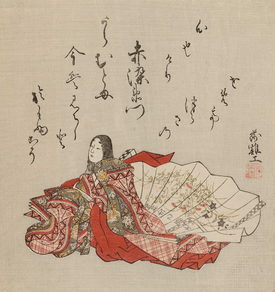Akazome Emon
Akazome Emon (赤染衛門, 956–1041) was a Japanese waka poet and early historian who lived in the mid-Heian period. She is a member both of the Thirty Six Elder Poetic Sages (中古三十六歌仙 Chūko Sanjūrokkasen) and the Thirty Six Female Poetic Sages (女房三十六歌仙 Nyōbō Sanjūrokkasen).
Biography
Emon is thought to be the daughter of Akazome Tokimochi, but her biological father was likely her mother's first husband, Taira Kanemori. Emon was born before her mother's marriage to Tokimochi in the Akazome family. Her husband Ōe no Masahira was a famous literary scholar, and the couple were considered to be "lovebirds" (おしどり夫婦 oshidori fūfu). She had two children, Ōe no Takachika and Gōjijū, and at least one grandchild, Ōe no Masafusa. In 1012, after her husband drowned, she lost her interest in religion and in raising her children.
Akazome Emon served Minamoto no Rinshi and Fujiwara no Shōshi, respectively the wife and daughter of Fujiwara no Michinaga, and she was present at the Imperial court at the same time as Izumi Shikibu. She was a contemporary of Murasaki Shikibu, who praised her writing, and Sei Shōnagon. She took part in two poetry competitions in 1035 and 1041.
A collection of her poetry is published as the Akazome Emon Collection (赤染衛門集 Akazome Emon Shū). She is believed to be the chief author or compiler of the Eiga Monogatari, an epic that chronicles Fujiwara history and serves as an important follow-up to the earlier Rikkokushi.
Poetry examples
- Akazome Emon composed this poem upon learning that Ōe no Tamemoto was headed to the Eastland (しかすが shikasuga). This is a poem of parting (離列(の)哥 wakare (no) uta); several official poetry anthologies followed the lead of Kokin Wakashū in having entire chapters devoted to such poems of parting. While the poem appears on the surface to be a trivial remark, she had no hope of Ōe no Tamemoto ever returning; thus this poem is an unsaid goodbye.
- 惜ともなき物ゆへにしかすがの 渡と聞けばたゞならぬ哉
- woshimu tomo nakimono yuhe ni shikasuga no watari to kikeba tada naranu kana (classical kana orthography)
- loosely: Though I have no reason for regret, upon hearing that you are headed to Shikasuga I am not completely indifferent.
- (Shūi Wakashū 6:316, written c. 985)
- This poem was composed on the anniversary of Ōe no Mashashira's death. This is a classic example of explicit seasonal reference, pioneered in the poems on seasons in the Kokin Wakashū, that is typical of Heian poetry.
- こぞの春ちりにし花も咲きにけり 哀れ別のかゝらましかば
- kozo no haru chirinishi hana mo sakinikeri ahare wakare no kakaramashikaba (classical kana orthography)
- loosely: The fallen blossoms of last spring are in bloom again. Oh if it were so with our painful parting!
- (Shika Wakashū 10:402)
Notes
| Wikimedia Commons has media related to Akazome Emon. |
References
- Hiroaki Sato (2008). Japanese women poets: an anthology. M.E. Sharpe, Inc.
- Earl Miner; Hiroko Odagiri; Robert E. Morrell (1985). The Princeton Companion to Classical Japanese Literature. Princeton University Press. p. 141.
